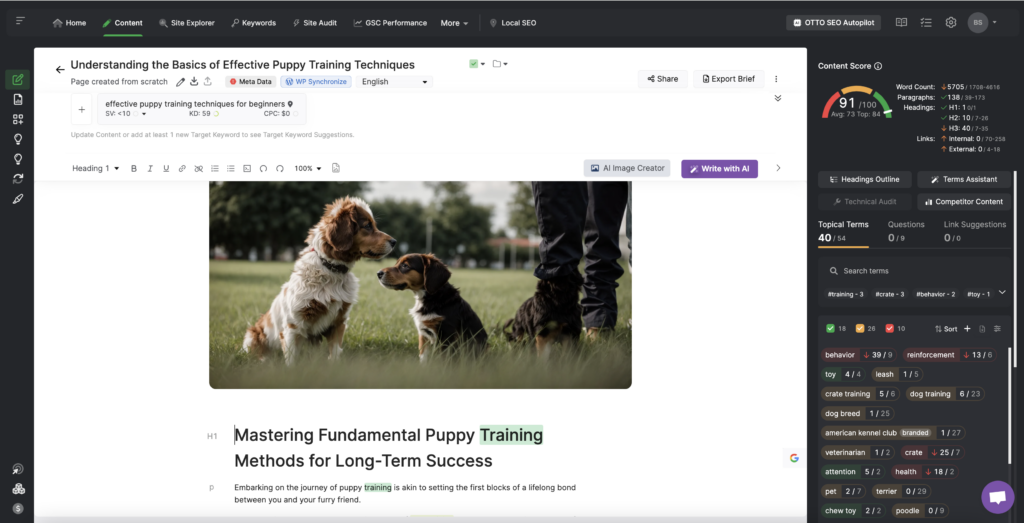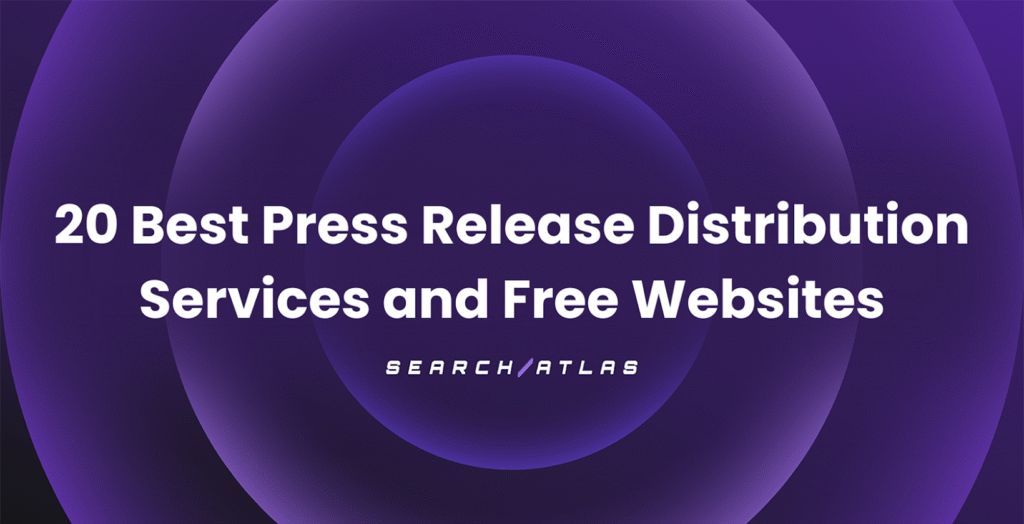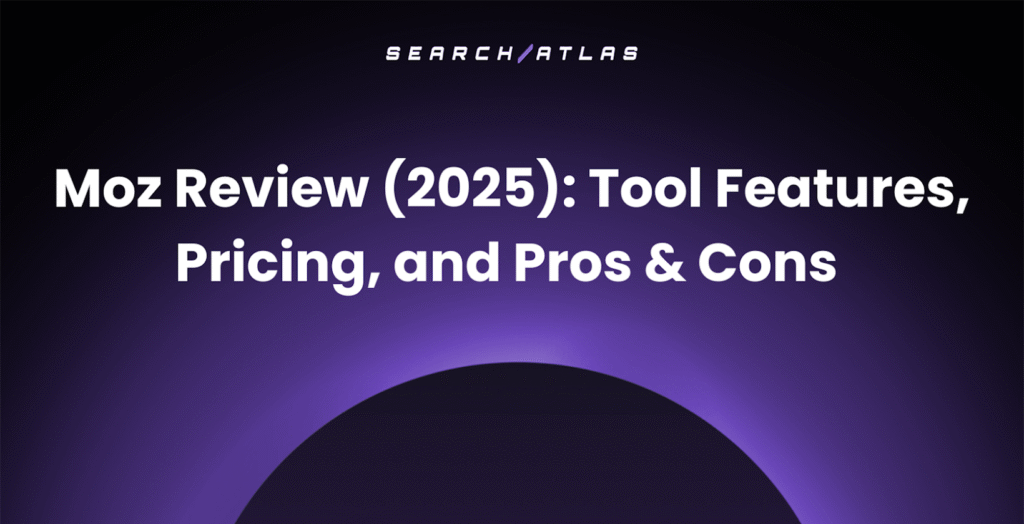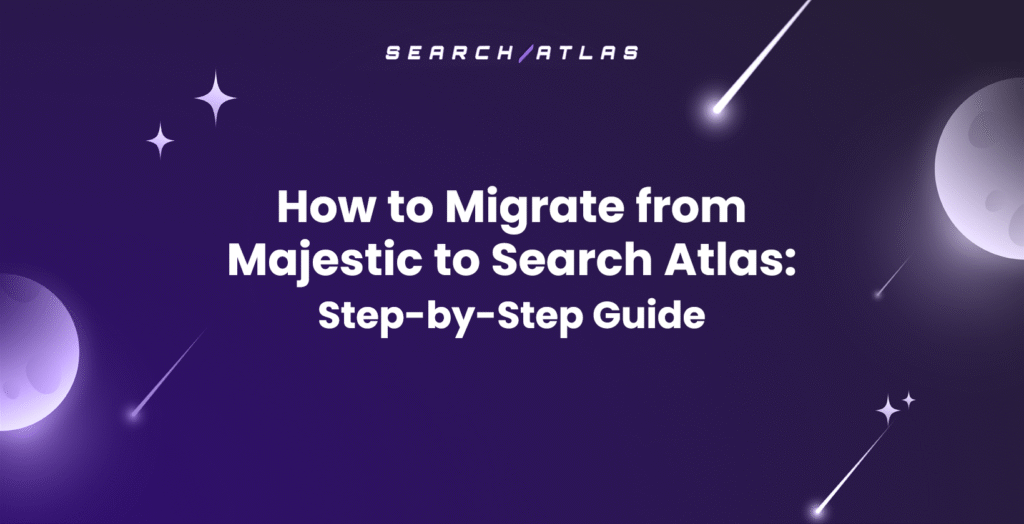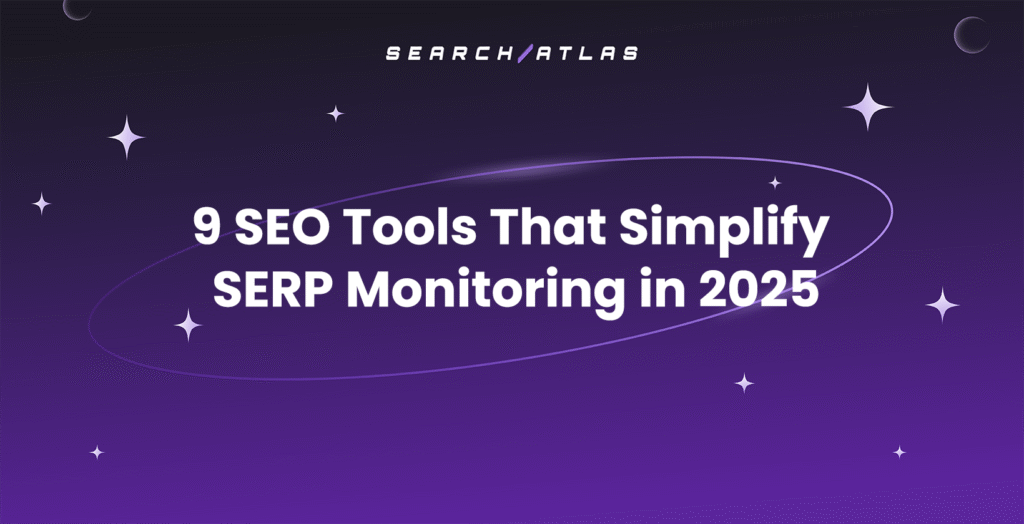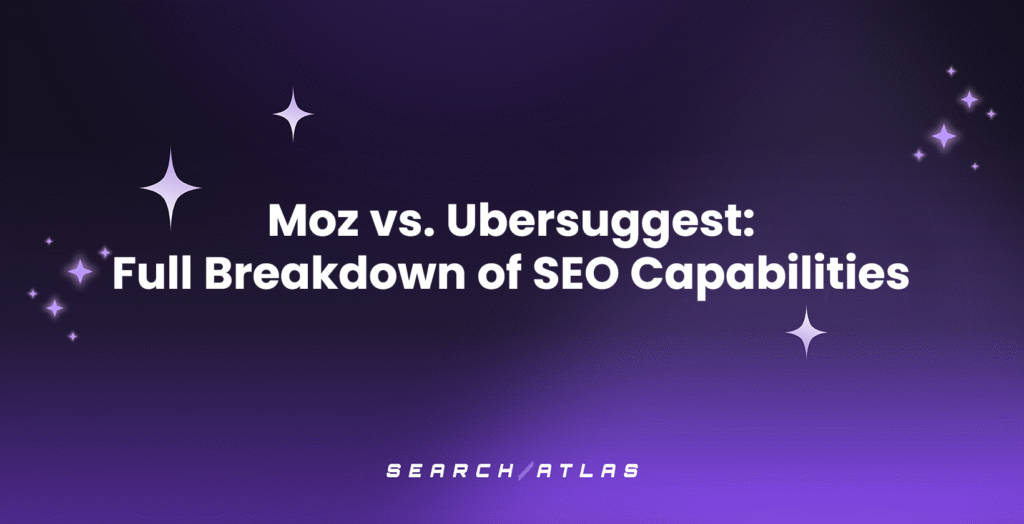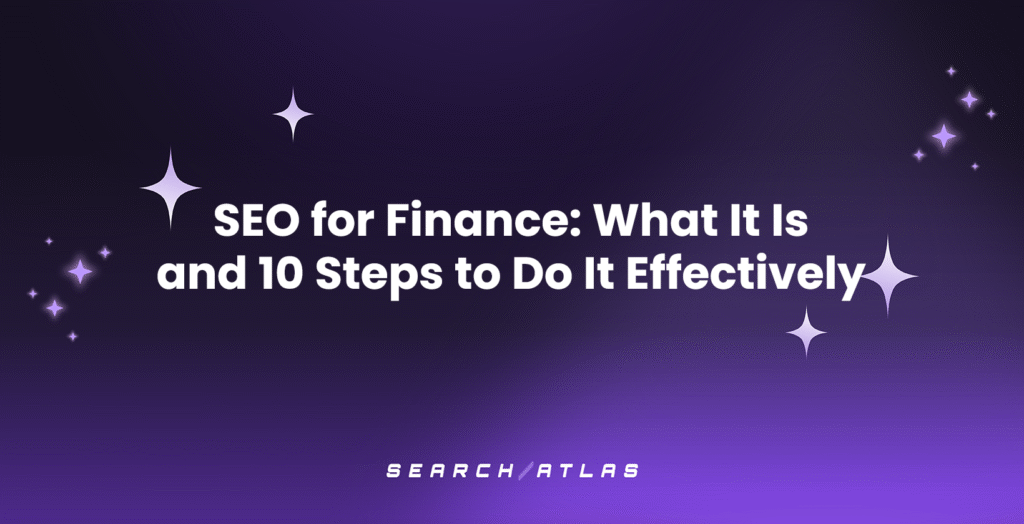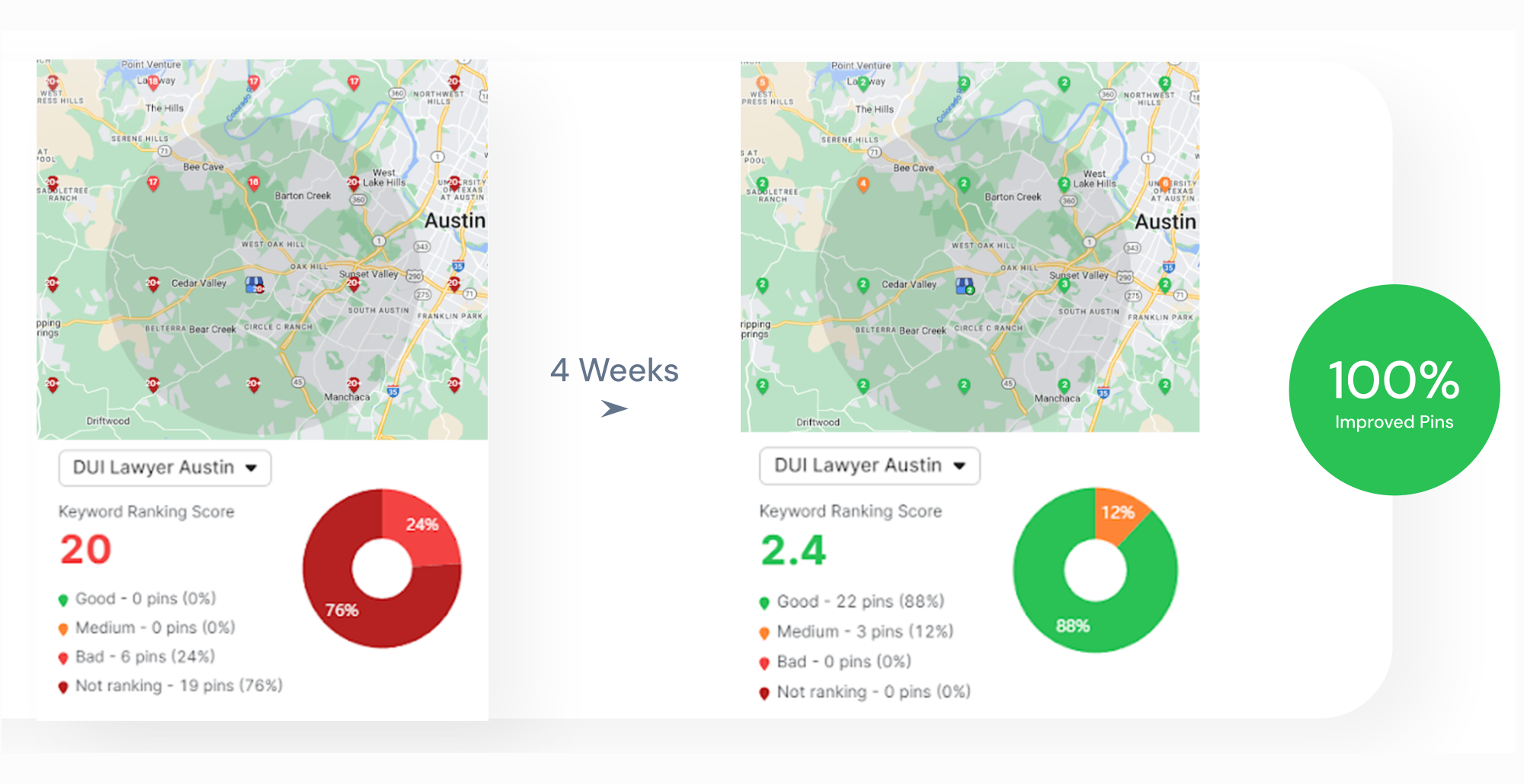On-page SEO refers to the practice of optimizing individual web pages to rank higher and earn more relevant traffic in search engines. On-page search engine optimization involves optimizing the page’s content and HTML source code. Effective on-page SEO guides search engines like Google to understand your website’s content and identify whether it is relevant to a searcher’s query.
The importance of on-page SEO lies in its ability to influence search visibility and user experience directly. Well-optimized pages communicate clear relevancy signals to search engines while providing valuable content to users.
Key on-page SEO ranking factors include keyword optimization, content quality, meta title tags, URLs, headings, and internal linking. By implementing proven on-page SEO techniques like keyword research, content optimization, and proper HTML structure, businesses can significantly improve organic search performance and drive more targeted traffic to their websites.
What is On-Page SEO?
On-page SEO, also known as on-site SEO, refers to the process of optimizing individual web pages’ HTML source code and content. On-page SEO focuses on content quality, HTML source code, and overall user experience within the website itself. Unlike technical SEO, which emphasizes website infrastructure, or off-page SEO, which centers on external signals like backlinks, on-page SEO directly enhances how search engines interpret your content’s relevance and value.
The primary objective of on-page SEO is to align content with specific keywords and topics that users are searching for. On-page SEO creates a clear connection between user queries and webpage content, increasing the likelihood of higher rankings. On-page SEO focuses on providing valuable, relevant information that satisfies user intent while ensuring technical elements support optimal visibility in search results.
What is On-Page Optimization in the Overall SEO Strategy?
On-page optimization is the foundation of a strong SEO strategy, contributing to relevance, clarity, and usability. Without well-structured on-page SEO, even high-quality backlinks and strong technical SEO cannot compensate for poor content or site experience.
On-page optimization contributes to the overall SEO strategy in several ways listed below.
- On-page SEO establishes relevance signals that help search engines match your content with appropriate search queries.
- On-page SEO enhances crawlability, making it easier for search engines to discover, interpret, and index your content.
- On-page SEO improves user experience metrics like dwell time, bounce rate, and click-through rate, which influence rankings.
- On-page SEO builds topical authority by demonstrating expertise within specific subject areas.
- On-page SEO increases conversion potential by aligning content with user intent to attract qualified traffic.
On-page SEO bridges technical implementation and content strategy, making sure that your website’s content is accessible to search engines and recognized as relevant and valuable for targeted keywords.
What is the Importance of On-Page SEO?
The importance of on-page SEO lies in its direct impact on search engine rankings, user experience, and overall website performance. On-page optimized websites increase click-through rate (CTR), improve crawl rate, and refine clarity for search engines.
On-page SEO grabs users’ attention and entices them to click on the website over other results in SERPs. The well-crafted meta titles and descriptions serve as effective advertisements for content in search results. It makes the website more likely to appear higher in SERPs, leading to more visibility and organic traffic. The strategic optimization of content ensures search engines can identify relevance to specific search queries.
On-page SEO has become increasingly important as search engines have evolved to prioritize user experience and content quality. Google’s algorithm updates consistently reward websites that provide valuable, well-structured content that satisfies user intent.
Unlike off-page factors that can take months to develop, on-page optimizations provide immediate opportunities to improve search visibility and traffic.
For businesses of all sizes, an on-page SEO strategy represents one of the most cost-effective marketing investments. While paid advertising stops generating results when campaigns end, properly optimized content continues driving traffic and conversions long-term. This sustainable approach to visibility makes on-page SEO essential for building a lasting online presence and authority.
What are the Most Important On-Page SEO Ranking Factors?
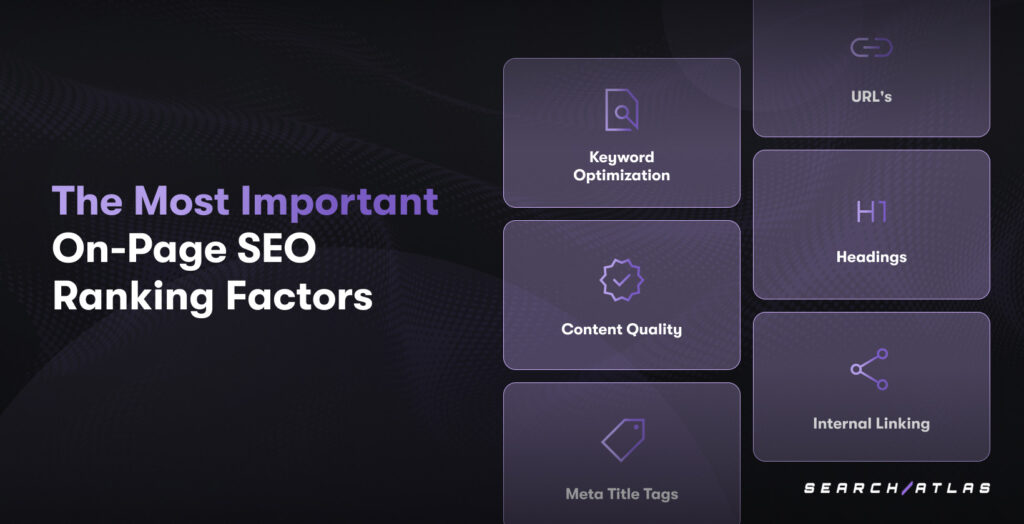
The most important on-page SEO ranking factors determine how search engines evaluate and rank web pages based on their content and structure. On-page SEO ranking factors influence visibility in search results through elements that website owners can directly control and optimize. Understanding SEO ranking factors helps prioritize optimization efforts for maximum impact.
The 6 most important on-page SEO ranking factors are listed below.
- Keyword Optimization. Keyword optimization is the process of strategically placing targeted keywords and related terms throughout the content. Keyword optimization requires matching the user intent to allow Google and the users to understand the page’s focus. The placement of keywords in title tags, headings, meta descriptions, and naturally throughout content signals relevance to search engines.
- Content Quality. Content quality refers to the value, relevance, and engagement level of the website’s content. Content quality should be valuable, informative, relevant, and engaging, leading to higher user engagement and aligning with Google’s focus on content relevance and expertise signals. Creating comprehensive, original content that thoroughly addresses user questions demonstrates expertise and authority to search engines.
- Meta Title Tags. Meta title tags are code elements that provide data about web pages and appear as clickable headlines in search results. Meta title tags need to reflect user intent, making them informative and enticing, which encourages users to click the page. Including primary keywords near the beginning of title tags maximizes their impact on search relevance and user attention.
- URLs. URLs are the web addresses used to access specific pages. URLs should be clear, descriptive, and aligned with user intent, making content more accessible and improving crawlability. The structure of URLs provides context about content hierarchy and topic relevance, with shorter, keyword-focused URLs generally performing better in search.
- Headings. Headings create a hierarchical structure (H1, H2, H3, etc.) used to organize content. Headings should be clear, have keyword-rich text, and be mostly question-based to enhance readability, topical relevance, and user experience. The proper implementation of heading hierarchy helps both users and search engines understand content organization and importance.
- Internal Linking. Internal linking is the practice of linking to other pages within the same website. Internal links must connect to relevant pages, improving navigation, boosting topical relevance, and increasing user engagement and interaction. The strategic use of internal links distributes page authority throughout the site and creates topical clusters that strengthen subject matter relevance.
What are the Basic On-Page SEO Techniques?
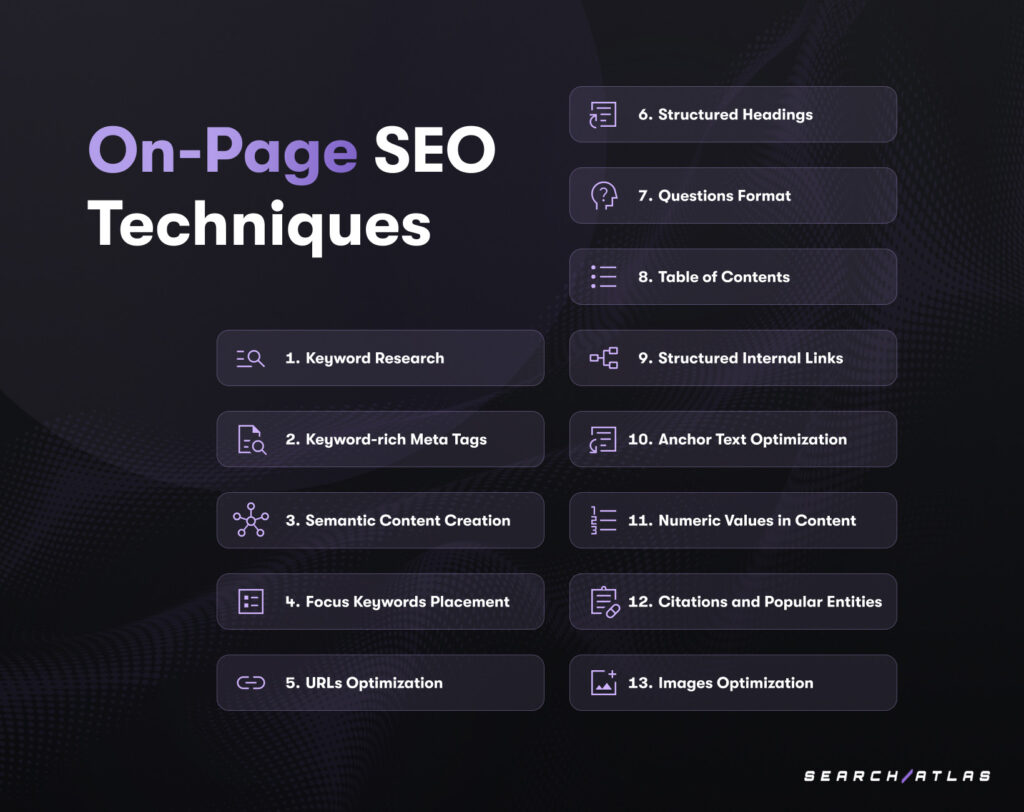
There are 13 basic on-page SEO techniques that improve on-page website performance. The 13 on-page SEO techniques are listed below.
1. Conduct in-depth Keyword Research to Understand User Intent
Conducting in-depth keyword research forms the foundation of an effective on-page SEO strategy by analyzing user search behavior and related search activities. In-depth keyword research involves the 4 steps listed below.
- Identifying target keywords. Use tools like the Search Atlas Keyword Research Tool to find relevant terms with adequate search volume.
- Analyzing search intent. Determine whether users are looking for information, navigating to a specific site, or ready to make a purchase.
- Evaluating competition. Assess how difficult it will be to rank for specific terms.
- Finding semantic variations. Identify related terms, questions, and phrases users might search for.
A lawn care company might discover that “spring lawn care tips” has a good search volume with informational intent, while “lawn mowing service pricing” indicates commercial intent.
Thorough keyword research enables you to find more relevant terms, avoid keyword stuffing, create a natural reading experience for users, and signal to Google that your content is authoritative.
The Search Atlas Keyword Research Tool helps identify relevant keywords, related terms, and user search intents. The Search Atlas Keyword Research Tool presents the search intent for any keyword, along with the keyword difficulty score and the average monthly searches.
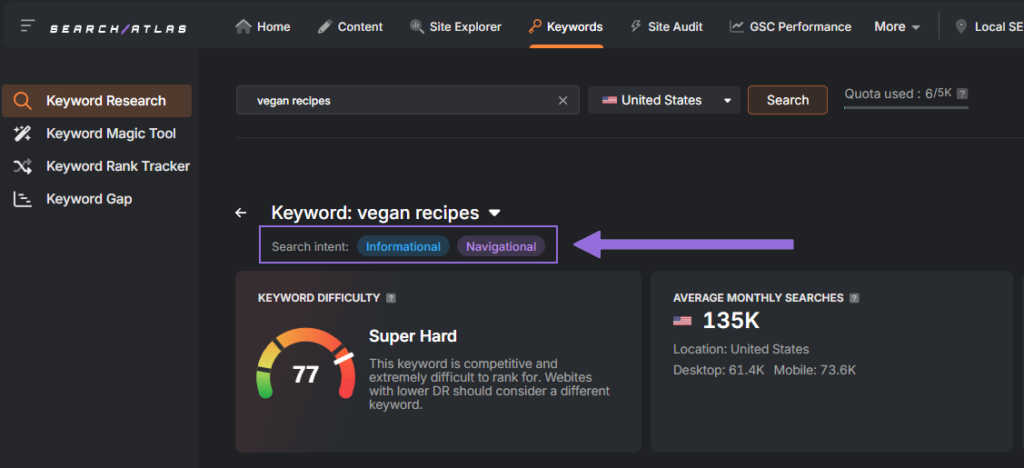
The Search Atlas Keyword Magic Tool quickly identifies the related searched terms for a keyword, their respective search intent, and search volume in one screen. The Search Atlas Keyword Magic Tool helps discover long-tail keyword variants that reveal specific user intentions when searching for that keyword.
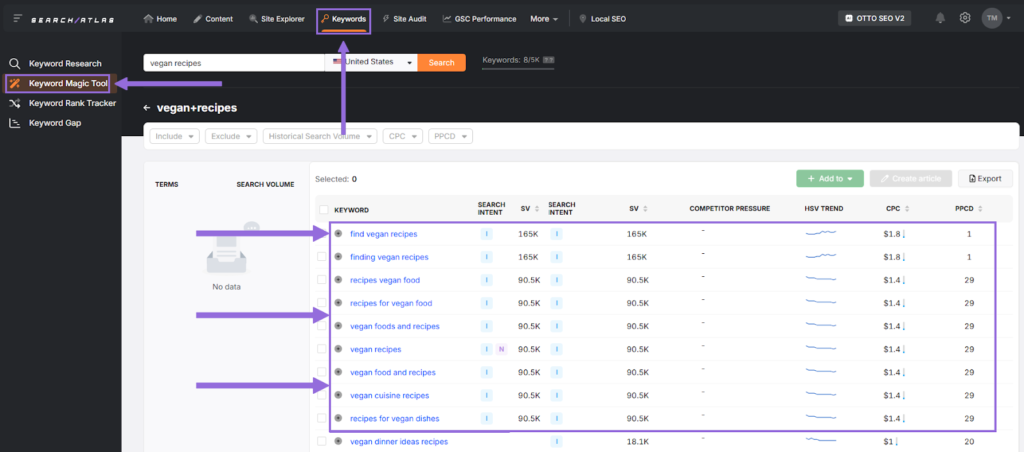
Google’s autocomplete and “People also search for” features, located at the bottom of the SERPs, can provide additional insights into long-tail keywords and related search terms.

These features reveal what users are actively searching for, helping align content with actual user questions and interests.

2. Write Keyword-rich Meta Tags and Optimize Them for CTR
Writing keyword-rich meta tags consists of crafting a meta title tag (or page title) and a meta description that incorporate target keywords while aligning with search intent.
Meta titles define the title of a web page and appear as the clickable headline in search engine results. Meta descriptions provide brief summaries of a webpage’s content that appear beneath the title in search results, further encouraging users to click on the link.

Both the meta title and meta description should have relevant keywords and resonate with user intent. Optimizing meta tags makes the website stand out in search results and increases the likelihood that users will click through to your site.
The Search Atlas Meta Generator Tool creates effective meta tags based on company name, page URL, page title, and target keywords. The Search Atlas Meta Generator Tool provides multiple suggestions for meta titles and descriptions that can be copied or downloaded for implementation.
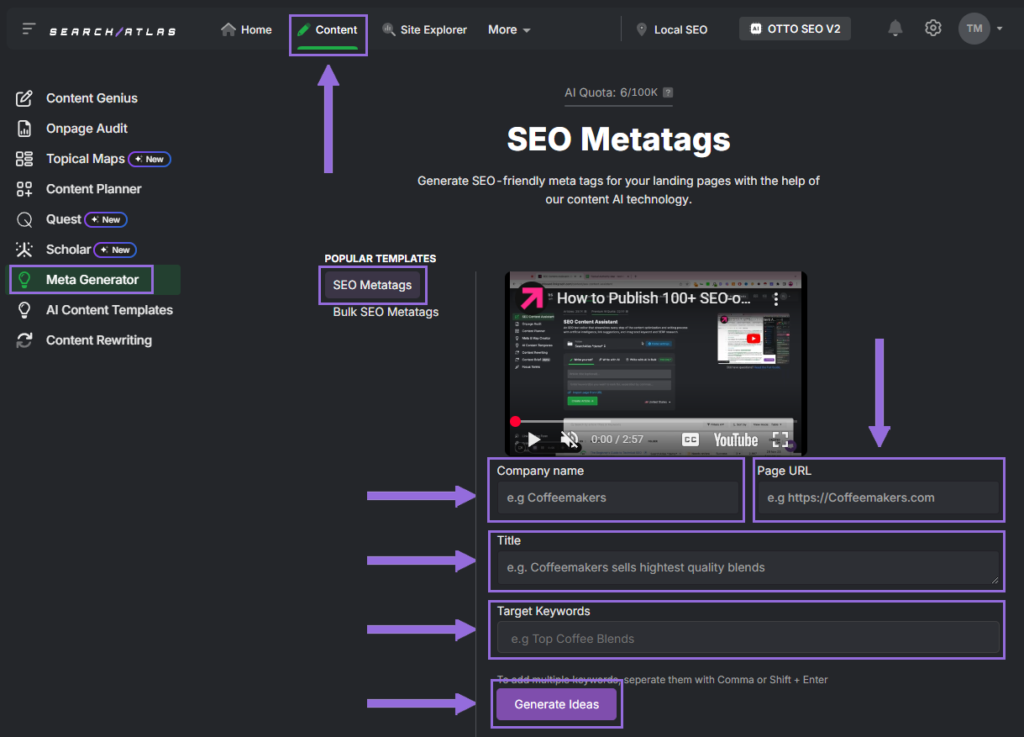
3. Write Semantic Content that is Unique, Relevant, and Helpful
Writing semantic content is the creation of content that is optimized for a topic rather than a single keyword or phrase. Semantic content considers the meaning and context of a topic by addressing user search intent and related search activities. Semantic on-page SEO content builds topic authority rather than focusing narrowly on specific keywords.
For example, rather than a basic 500-word article on “how to grow tomatoes,” create a comprehensive 2,000-word guide that covers soil preparation, planting techniques, watering schedules, pest control, and harvesting tips.
Unique, relevant, and helpful semantic SEO content attracts natural backlinks, further improving your website’s credibility and topical authority. The comprehensive coverage of topics signals expertise to search engines and provides greater value to users.
The Search Atlas Content Genius Tool helps you create unique, relevant, and helpful content with artificial intelligence. The Search Atlas Content Genius Tool generates articles automatically, enabling analysis of competitors’ content, selection of heading outlines, and inclusion of suggested topical terms, questions, and links. The AI-powered assistant streamlines content creation while ensuring alignment with SEO best practices.
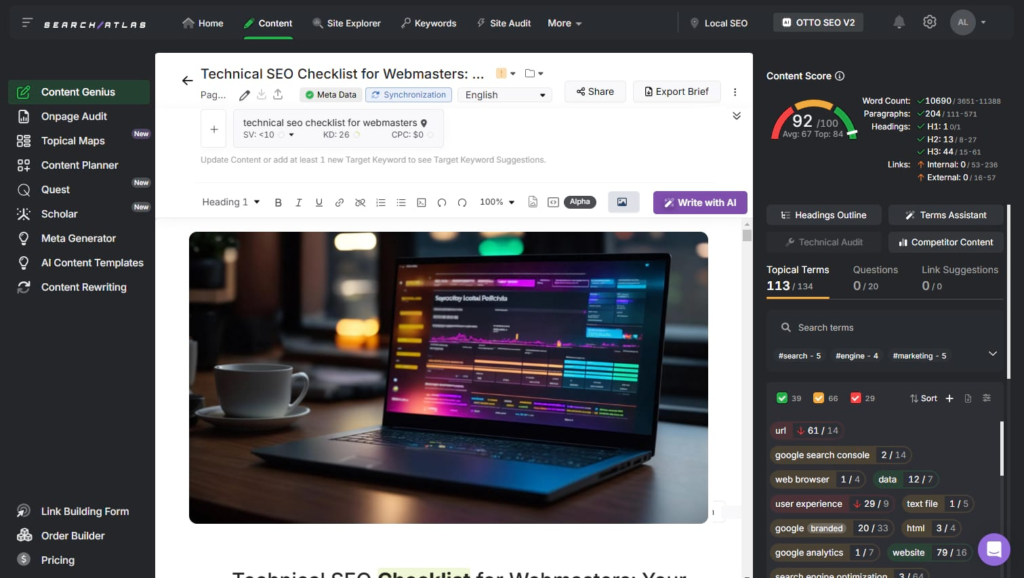
The Search Atlas Scholar Tool analyzes content characteristics relevant to Google’s quality algorithms, such as content clarity, query relevance, factuality, and information gain. The Search Atlas Scholar Tool evaluates published or unpublished content against specific keywords or topics to generate detailed semantic evaluation reports. This analysis is extremely useful as it provides actionable insights for content improvement based on search engine quality standards.
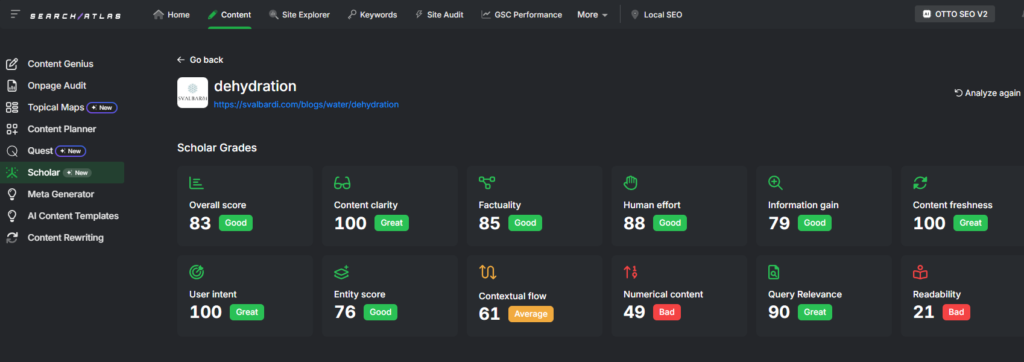
4. Place Focus Keywords Contextually to Build Topical Relevance
Placing focus keywords contextually means incorporating primary keywords naturally within the content, ensuring they align with the overall subject and user intent.
Strategic keyword placement helps search engines understand your content by leveraging natural integration, proper density, and contextual placement.
- Natural integration. Include keywords in a way that reads naturally.
- Proper density. Avoid keyword stuffing while maintaining relevance.
- Contextual placement. Use keywords in contextually relevant sentences.
Rather than forcing “best coffee maker” repeatedly into the text, write naturally about brewing methods, coffee maker features, and customer reviews while incorporating the keyword where it makes sense.
The Search Atlas On-Page SEO Audit Tool helps you identify if a page has issues with the keywords’ contextual placement. The Search Atlas On-Page SEO Audit Tool analyzes up to three focus keywords against the target URL to evaluate keyword implementation effectiveness.
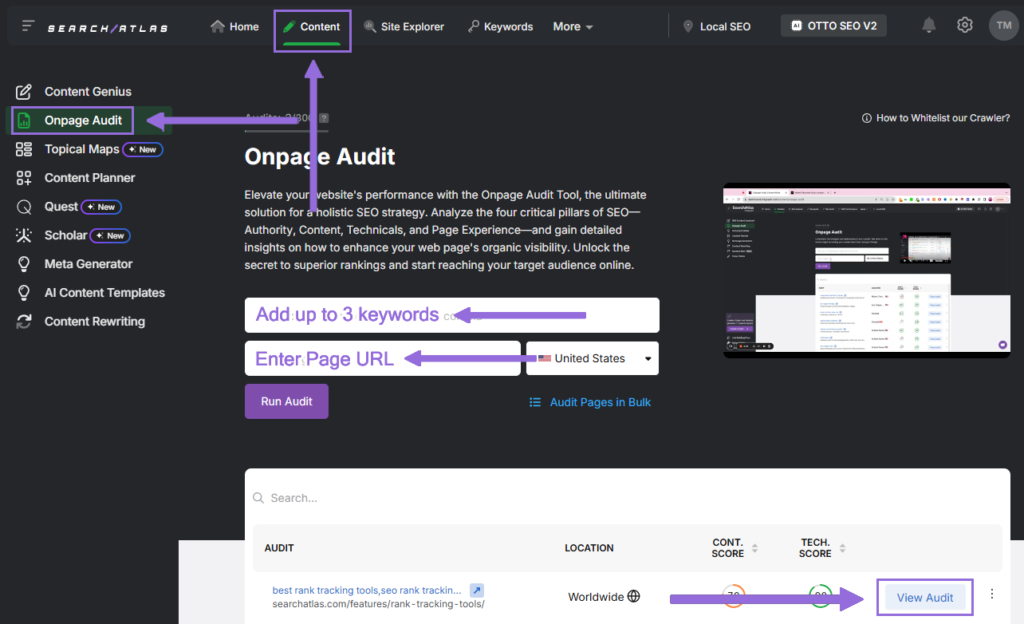
The analysis provides specific recommendations for keyword placement improvements throughout the page.
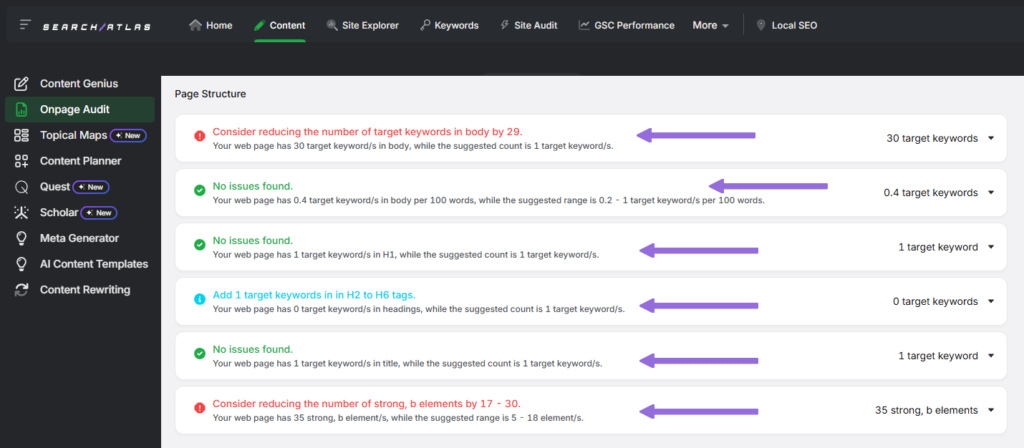
5. Optimize URLs to Flow the Context Between Pages
Optimizing URLs to flow the context between pages involves structuring the web addresses logically and hierarchically. The optimization of URLs enhances user experience and improves the crawl efficiency of search engines. The well-structured URLs provide immediate context about page content and its place within the overall site hierarchy.
The URLs should be descriptive, concise, keyword-rich, and have a logical structure.
- Descriptive. Indicate what the page is about clearly.
- Concise. Keep URLs short and to the point.
- Keyword-rich. Include the primary keyword.
- Logically structured. Organize URLs to reflect site hierarchy.
The Search Atlas On-Page SEO Audit Tool evaluates URL optimization by analyzing the technical structure and keyword implementation. The Page URL tab within the Search Atlas On-Page SEO Audit Tool provides specific recommendations for URL improvements. The analysis ensures URLs follow best practices for both search engine crawling and user navigation.

6. Use Structured Headings and Subheadings in Pages
Using structured headings and subheadings is the practice of organizing a webpage’s content with clear, hierarchical headings, such as H1, H2, H3, H4, and H5. Structured headings and subheadings improve the user experience and search engine understanding. The proper heading structure creates a content roadmap that guides both human readers and search crawlers through the information.
The recommendations for using structured headings and subheadings are listed below.
- H1 tag. Use only one H1 per page, typically matching or similar to the title.
- H2 tags. Use for the main sections of your content.
- H3-H6 tags. Use for subsections and smaller divisions.
Well-structured headings enable users to quickly identify the main sections of the page. The clear organization allows visitors to skim content and find the specific information they’re looking for. The logical structure improves accessibility for all users, including those using screen readers or other assistive technologies.
Clear headings enhance content comprehension for search engines, allowing Google and other search engines to better index and rank your content based on relevance. The proper heading hierarchy signals content importance and relationships between different sections. The keyword-rich headings provide additional relevance signals for specific search queries.
The Search Atlas On-Page SEO Audit Tool evaluates heading structure and provides best practices recommendations through the Page Headers tab. The audit identifies heading hierarchy issues, keyword implementation opportunities, and structural improvements. The analysis ensures headings follow on-page SEO best practices.
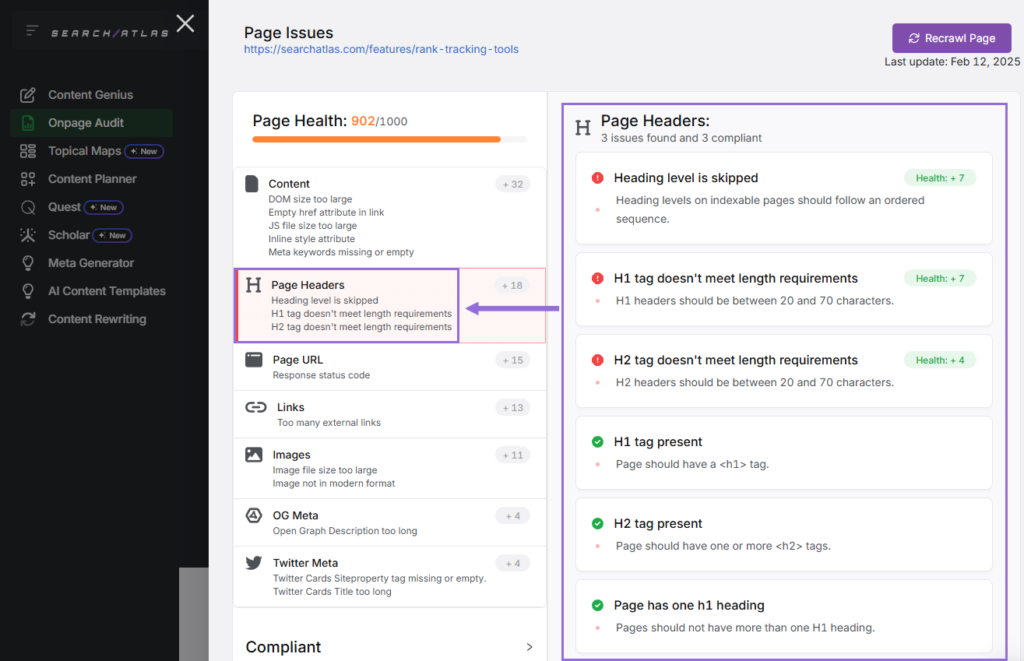
7. Use Question Format for Headings and Subheadings
Using a question format for headings and subheadings refers to phrasing your titles and section headings as questions. Many users search for answers to specific questions, so phrasing headings as questions increases the likelihood of matching search queries. Search engines generate questions from keywords. Using question formats for your headings allows search engines to process the content faster without the need for question generation.
For example, instead of “Tomato Planting Techniques,” use “How Do You Plant Tomatoes for Maximum Yield?”.
Headings with questions are effective when targeting informational content, FAQs, or solving specific user needs. The question format creates an immediate connection with users seeking answers to those exact questions. The structure sets up a clear promise to provide specific information that addresses the user’s query directly.
The Search Atlas On-Page SEO Audit Tool presents question-based searches related to the webpages’ focus keywords through the Topical Terms section. Identifying these questions helps create heading structures that align directly with common user queries.

. Implementing question-based headings increases the likelihood of ranking for these specific search terms and appearing in featured snippets.
8. Use Table of Contents for Better User Experience
A Table of Contents (TOC) is a list of links or headings placed at the beginning of a page that provides an overview of the entire content’s structure. Table of Contents allows users to navigate to specific sections of a page quickly, improving accessibility and overall user experience. TOC makes users more likely to find exactly what they’re looking for without scanning the entire content.
The tips for using the Table of Contents for a better user experience are below.
- Include a table of contents for articles over 1,500 words.
- Make it collapsible for mobile users.
- Use descriptive section names.
- Link to all major headings (H2s and possibly H3s).
For a 3,000-word guide on digital marketing, for example, a table of contents allows users to jump to sections on SEO, content marketing, social media, and email marketing, improving usability. A TOC helps users find specific information, makes content more accessible and engaging, generates jump links, and makes long-form content more manageable.
For WordPress websites, TOC plugins like Easy Table of Contents and LuckyWP Table of Contents automate the creation of navigation structures. These plugins automatically generate a table of contents for present and future content based on the heading structure. The automatic implementation ensures consistency across the website while saving time in content production.
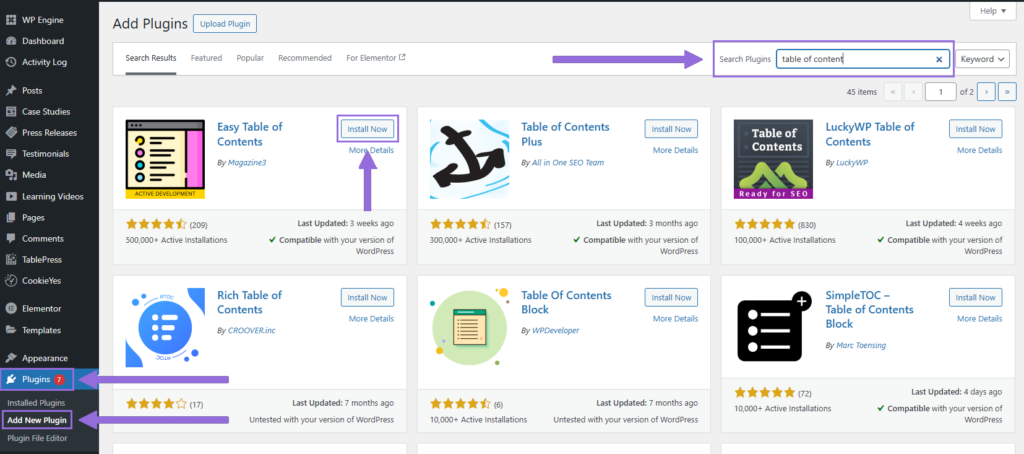
TOC plugins automatically create a table of contents for present and future content.
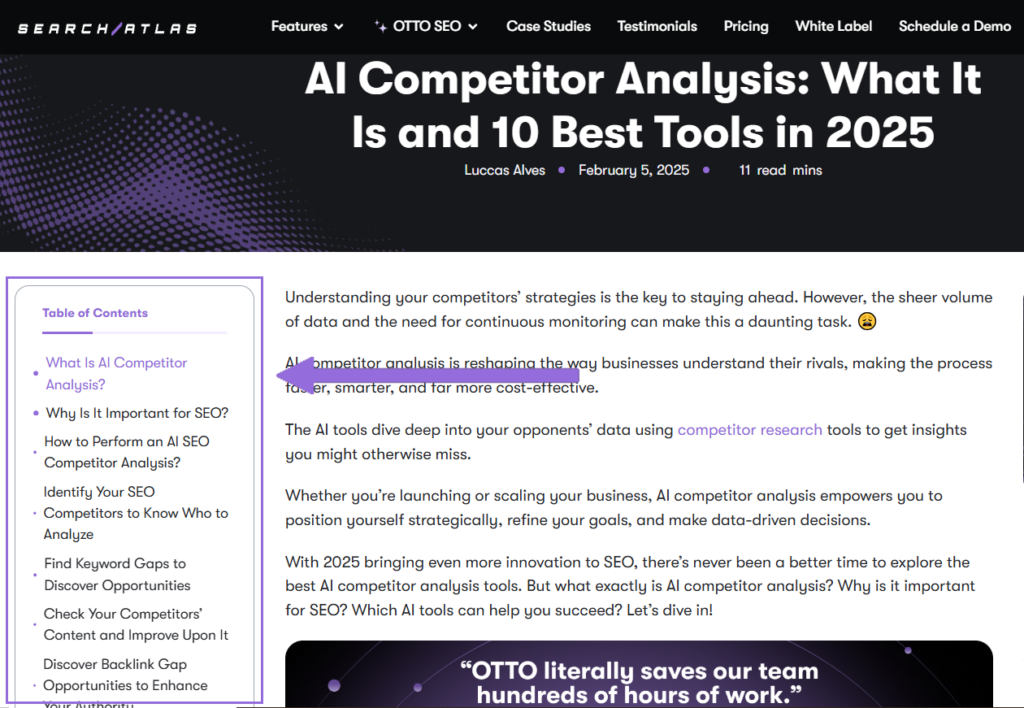
9. Add Structured Internal Links to Flow the Context Between Pages
Adding structured internal linking refers to the practice of linking related pages or articles within your website while following a contextual website structure and using relevant anchor texts.
Strategic internal linking establishes site architecture by showing relationships between content. Internal linking distributes link equity by passing authority to important pages, helps users find related content, and encourages users to explore more of your website.
The Search Atlas On-Page SEO Audit Tool analyzes the internal linking of a webpage and provides actionable insights for improvement through the Links tab. The audit identifies opportunities for additional internal links, evaluates anchor text optimization, and checks for broken or redirected links. The comprehensive analysis ensures internal linking follows best practices for both SEO and user experience.

10. Optimize Anchor Text for Better Topical Relevance
Optimizing anchor text is the strategic use of chosen keywords or phrases as clickable links that lead to relevant pages within your website or external sites. Anchor text optimization for topical relevance aligns the content of the linked page with the website’s overarching theme or topic. The descriptive anchor text assists users and search engines in understanding the context and subject matter of the linked content.
For example, instead of “click here,” use “complete guide to on-page SEO techniques” as anchor text for a link to 7an SEO guide.
Adequate anchor text provides clear expectations about what users will find when clicking a link. The descriptive text improves user experience by reducing uncertainty about linked destinations. The contextual anchor text contributes to lower bounce rates and higher engagement with internal content.
The Search Atlas Backlink Research Tool analyzes anchor text optimization by evaluating incoming links to the website, subdomain, or specific page. The Anchor Text tab displays all anchor text for the analyzed target, allowing assessment of keyword distribution and relevance. The Search Atlas Backlink Research Tool helps identify opportunities to improve anchor text diversity and relevance for internal and external links.
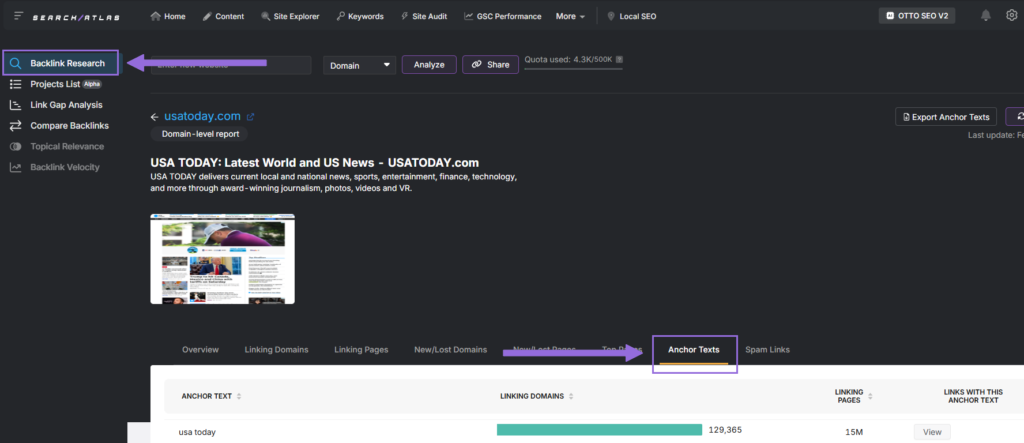
11. Use Numeric Values in Content to Show Expertise
Using numeric values in content means incorporating precise data, statistics, or figures within your writing to support your points, strengthen your arguments, and present factual, verifiable information. Integrating numeric values into content enhances its credibility and authority, making it clear that the claims are backed by research or measurable outcomes. The specific data points demonstrate expertise and thorough research on the subject matter.
Numeric content signals that the information presented is precise and well-researched. Including statistics and specific figures increases the perceived authority of the content. The data-driven approach differentiates content from vague, general information found on competing pages.
The Search Atlas Scholar Tool analyzes the numbers found in the content and presents the numerical data score. The evaluation helps identify opportunities to strengthen content with additional numeric values. The data-focused approach improves content credibility and depth, supporting higher rankings and user trust.

12. Present Evidence by Using Citations and Popular Entities in the Topic
Presenting evidence by using citations and popular entities means backing up claims with references to authoritative sources, studies, or experts within the content’s field.
Citations are specific references to external sources, whether articles, books, or research papers, that validate the points being made. Popular entities refer to well-known figures, brands, organizations, or concepts within a niche that lend credibility to the content.

Providing evidence through citations enhances authority by showing research and knowledge of the field. It contributes to expertise, authoritativeness, and trustworthiness (E-A-T) and creates entity relationships by connecting your content with recognized authorities.
13. Use Unique, Relevant, and Branded Images
Using unique, relevant, and branded images means incorporating original visuals that are contextually connected to the content and represent the brand’s identity. Unique, relevant, and branded images allow search engines to understand the content better. Optimizing these visuals following image SEO principles enhances their discoverability in image search, improving visibility and engagement. The visual elements make the content more appealing, break up text, and transform complex topics into more digestible content.
Original images provide additional ranking opportunities through image search. The unique visuals create opportunities for backlinks when other sites reference the images. The branded elements strengthen recognition and association with the website across multiple touchpoints. Proper image SEO practices, such as using descriptive file names, alt text, and compression, ensure that images contribute to page performance and search rankings.
The best practices for using images for on-page SEO are listed below.
- Use descriptive, keyword-rich file names (e.g., on-page-seo-factors-infographic.jpg).
- Add alt text that describes the image and includes relevant keywords.
- Compress images for faster loading.
- Create branded templates for a consistent visual identity.
- Include captions where appropriate for additional context.
The Search Atlas On-Page SEO Audit Tool provides insights to improve images through the Images tab, including file size, format, and image alt attributes. The analysis identifies opportunities to optimize images for user experience and search visibility. The recommendations ensure visuals contribute positively to both page performance and search rankings.

On-page SEO basics still make a big difference in 2025. While search algorithms continue to evolve, the fundamental principles of creating well-structured, relevant, and valuable content remain essential.
What are the Advanced On-Page SEO Techniques?
There are 4 advanced on-page SEO techniques. The 4 advanced on-site SEO techniques are explained below.
1. Optimize Pages for Better Page Speed
Optimizing pages for better page speed includes improving how quickly webpages load by reducing unnecessary elements, optimizing assets, and improving server response times.
Faster pages keep visitors engaged longer and improve conversions by ensuring users don’t get frustrated with slow load times. Speed optimization makes it easier for search engines to crawl and index content efficiently.
You need to pay attention to image optimization, code minification, browser caching, and the critical rendering path.
- Image optimization. Compress images, use next-gen formats like WebP, and implement lazy loading.
- Code minification. Reduce unnecessary characters in HTML, CSS, and JavaScript.
- Browser caching. Set appropriate cache headers to store resources locally.
- Critical rendering path. Optimize CSS delivery and defer non-critical JavaScript.
The Search Atlas On-Page SEO Audit tool evaluates page speed factors, including DOM size, JS file size, and CSS file size, through the Content tab.
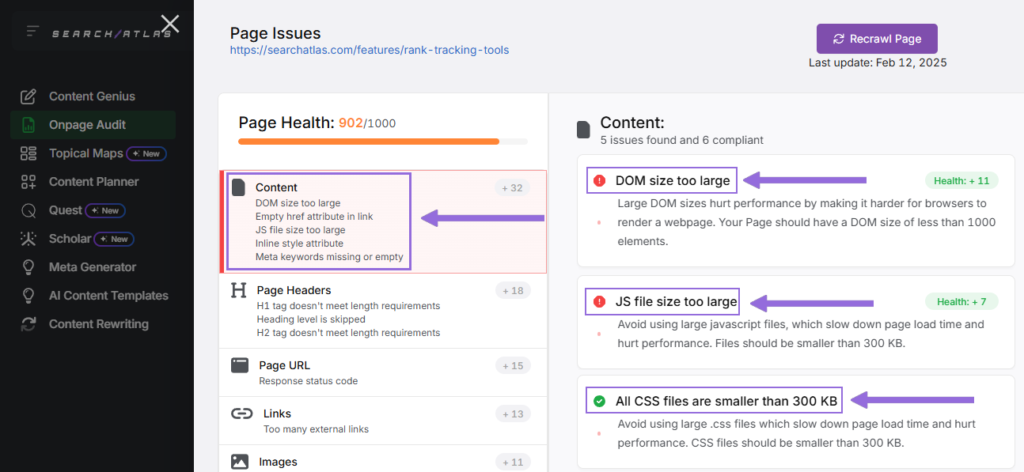
The Search Atlas On-Page SEO Audit analyzes image file size and format, both attributes that significantly affect page load speed. The comprehensive analysis provides specific recommendations for reducing file sizes and improving overall page performance.

Google PageSpeed Insights (PSI) provides additional information about page speed and actionable insights for improvement within the Diagnostics section.

2. Optimize for Question Answers to Trigger Featured Snippets
Optimizing for question answers to trigger featured snippets refers to structuring content to directly answer user queries in a clear, concise, and well-formatted way. Google pulls answers into featured snippets, often appearing at the top of SERPs in position zero. The featured snippet optimization increases visibility and drives significant traffic from users seeking quick answers.
For example, structuring a section with the heading “What is On-Page SEO?” followed by a concise, factual definition in the first paragraph increases the chance of being featured as a snippet.
Users are more likely to engage with content that provides quick, direct answers to their questions. The clear response format improves user satisfaction and positions the website as an authoritative source. The question-answer structure aligns naturally with voice search queries, enhancing visibility across multiple search methods.
Google’s People Also Ask feature provides insights into related questions that users commonly search for. Expanding content to address these related queries increases opportunities for featured snippet appearances and strengthens overall subject matter authority.

3. Add Schema Markup to Pages
Adding schema markup to pages means embedding structured data that enables search engines to better understand and categorize your content. Schema markups provide organized data about your page, such as product details, reviews, authors, and FAQs. The structured data implementation clarifies content type and purpose for search engines, enhancing interpretation accuracy.
The commonly used schema types are below.
- Local business schema. Enhances visibility for local searches.
- FAQ schema. Displays frequently asked questions directly in search results.
- HowTo schema. Shows step-by-step instructions in search results.
- Product schema. Displays prices, availability, and ratings in product listings.
- Article schema. Provides additional context for news and blog content.
For example, implementing FAQ schema on a service page could increase SERP real estate by displaying 3-4 questions and answers directly in search results.
The Search Atlas On-Page SEO Audit Tool provides information and actionable recommendations about schema markups through the Schema tab.
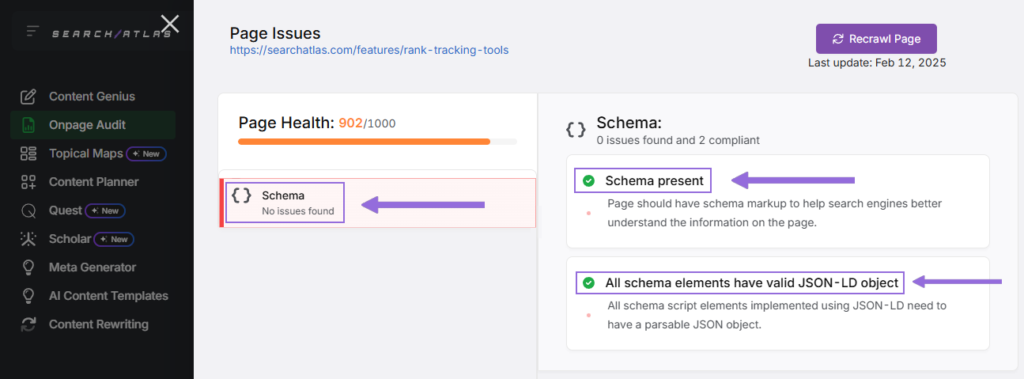
The Search Atlas Schema Creator Tool generates proper schema markup for various content types. The testing feature ensures structured data implementation meets technical requirements before deployment.
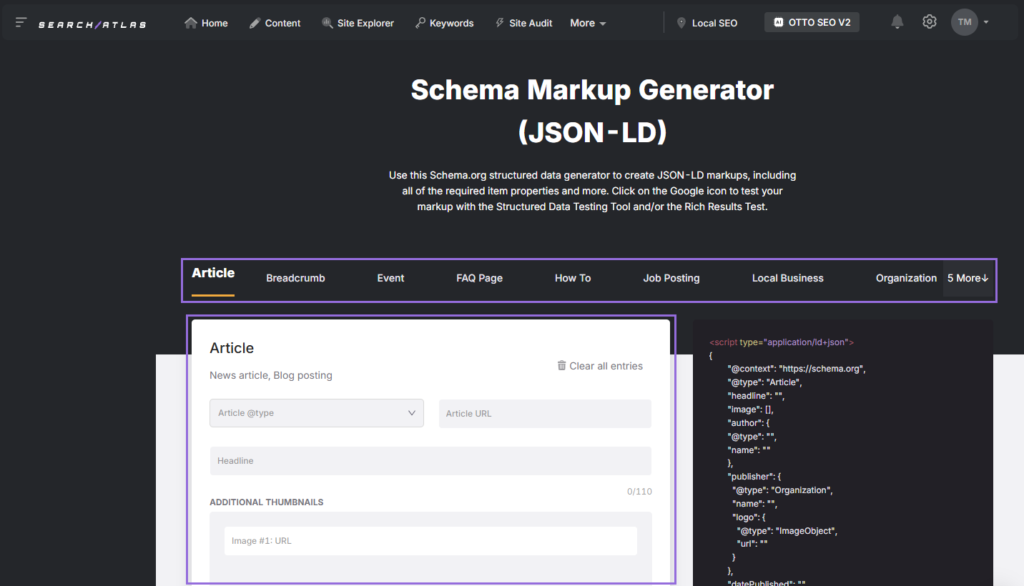
4. Optimize Content for Voice Search
Optimizing content for voice search involves structuring your content to match the way people naturally speak when using voice assistants like Google Assistant, Siri, or Alexa. The optimization of content for voice search involves focusing on conversational language and question-based queries. The natural language approach aligns with how users verbally request information through voice-enabled devices.
Voice search considerations are listed below.
- Queries tend to be longer (7+ words).
- Questions often begin with who, what, where, when, why, and how.
- Results typically come from the top three organic positions.
Voice search SEO increases visibility in featured snippets and question-based queries, driving more traffic. The conversational content format improves user experience by delivering direct answers to specific questions. The question-oriented structure aligns with the growing trend of voice-activated searches across mobile and smart home devices.
The Search Atlas On-Page SEO Audit Tool identifies question-based queries through the Topical Terms section. The Questions tab reveals which question-based queries users search for most frequently related to the target topic. The voice search SEO insights help optimize content specifically for voice search patterns, expanding potential search visibility.
How Often Should On-Page SEO Be Done?
On-page SEO should be done every 1 or 2 months to maintain optimal search visibility and user experience. Different on-page SEO tasks should be scheduled at regular time intervals based on their impact and the rate of change in search algorithms and market conditions.
New pages should be optimized as they are published to establish strong initial visibility and performance. Keyword performance and content should be reviewed every one or two months to address changing search patterns and competitor activities. A complete on-page SEO audit should be conducted every 6 months to evaluate all aspects of website performance.
How to Improve On-Page SEO Using Search Atlas OTTO SEO?
On-page SEO involves multiple elements, including content optimization, metadata structuring, internal linking, and technical enhancements. Manually handling these aspects can be time-consuming and prone to human error. Search Atlas OTTO SEO automates the entire on-page SEO process with advanced AI capabilities, ensuring that every webpage is optimized for search intent, user experience, and technical compliance.
There are nine categories of issues that Search Atlas OTTO SEO fixes automatically, allowing businesses to optimize pages efficiently and at scale. The 9 categories of issues that Search Atlas OTTO SEO fixes automatically are listed below.
- Title Tags. Search Atlas Search Atlas OTTO SEO suggests an optimized title tag that is enticing, informative, and aligned with the page’s user intent, URL, keyword, and topic. The AI-generated titles balance keyword optimization with click-through rate potential.

- Meta Description. Search Atlas OTTO SEO generates a descriptive, informative, enticing meta description that is optimized for the page’s user intent, URL, keyword, and content. The compelling descriptions encourage clicks from search results while maintaining keyword relevance.
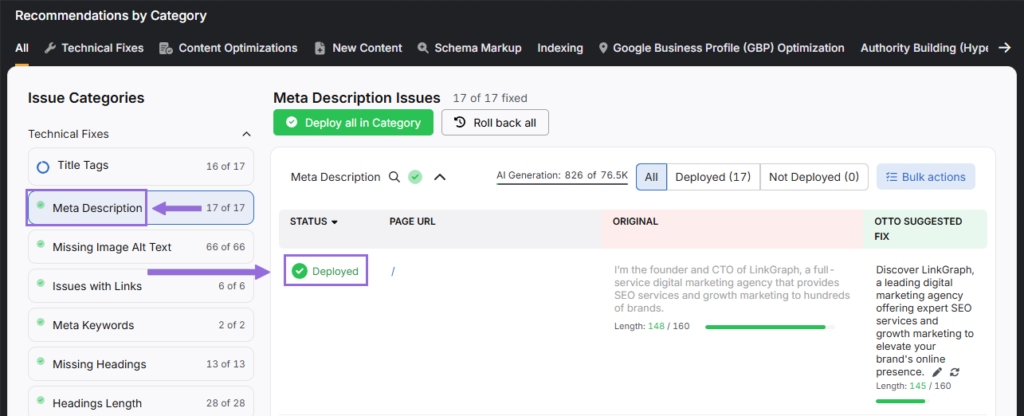
- Missing Alt Text. Search Atlas OTTO SEO identifies the images with missing alt text and suggests optimized descriptive text that matches what is presented in the images. The accessible image descriptions improve both SEO and accessibility compliance.

- Issues with Links. Search Atlas OTTO SEO identifies and fixes broken or redirected internal links by suggesting replacing them with new, working links that are relevant to the page. The link correction improves user navigation and search crawling efficiency.
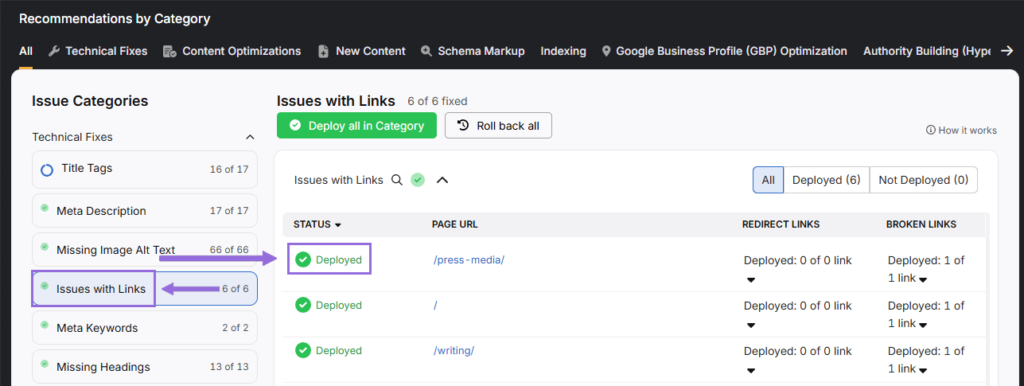
- Meta Keywords. Search Atlas OTTO SEO adds and optimizes meta keywords that are relevant and aligned with the page’s content. The keyword optimization strengthens topic relevance signals for search engines.
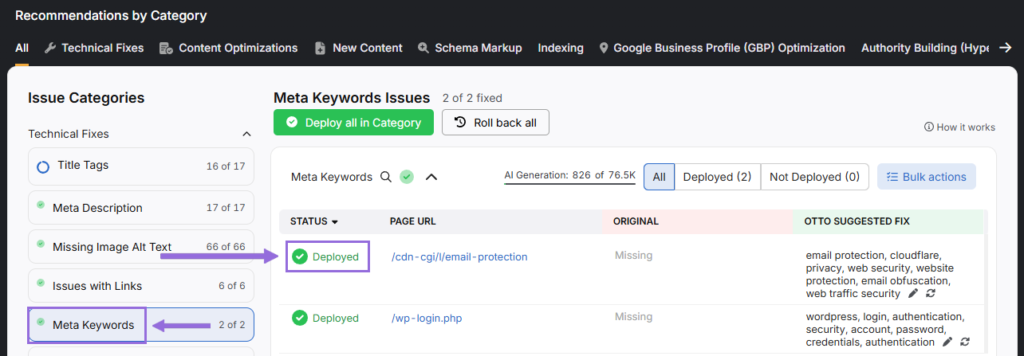
- Missing Headings. Search Atlas OTTO SEO identifies missing relevant headings on a page, suggests the headings and subheadings, and creates the text for them accordingly. The improved heading structure enhances content organization and readability.
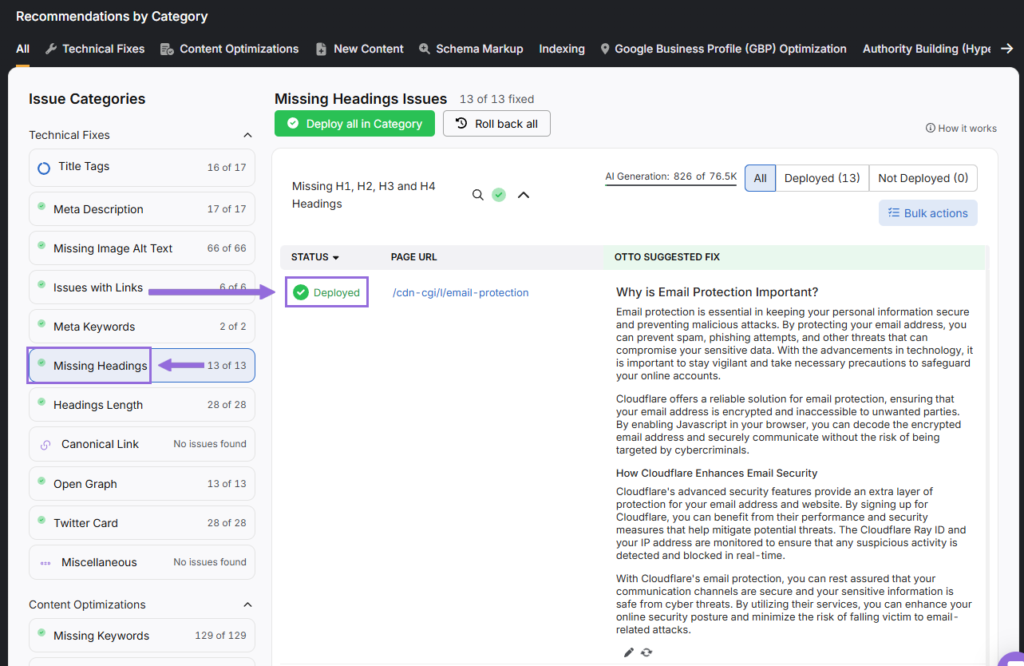
- Headings Length. Search Atlas OTTO SEO evaluates the headings’ length for each page and rewrites them to the recommended length. The optimized headings balance keyword inclusion with clarity and engagement.
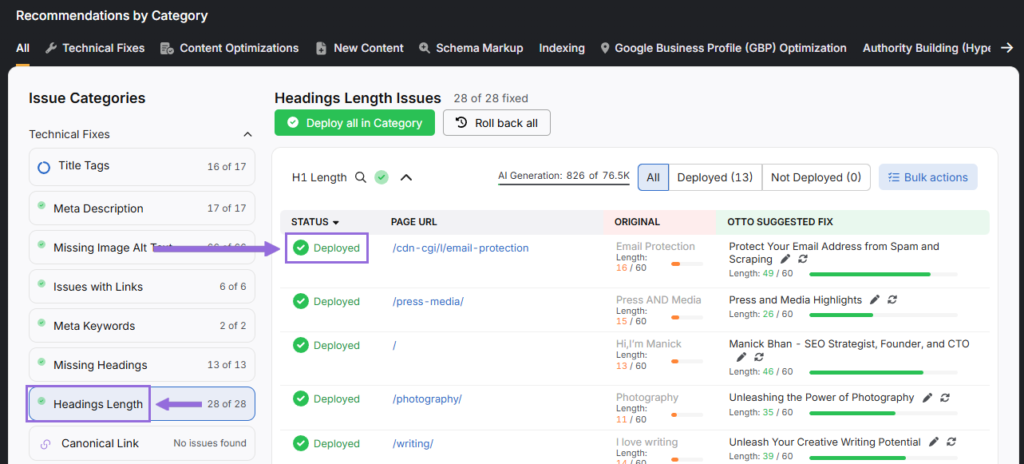
- Missing Keywords. Search Atlas OTTO SEO finds missing keywords that are relevant to the topic and integrates them naturally into the page’s content. The keyword enrichment strengthens topical relevance without compromising readability.
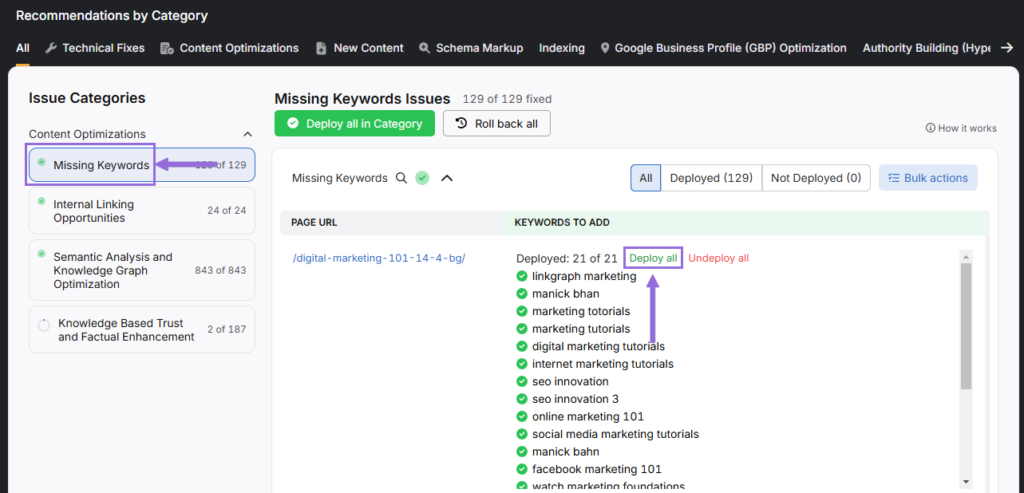
- Internal Linking Opportunities. Search Atlas OTTO SEO identifies missing internal linking opportunities and suggests them, along with the proper anchor text. The enhanced internal linking improves site navigation and distributes ranking signals effectively.
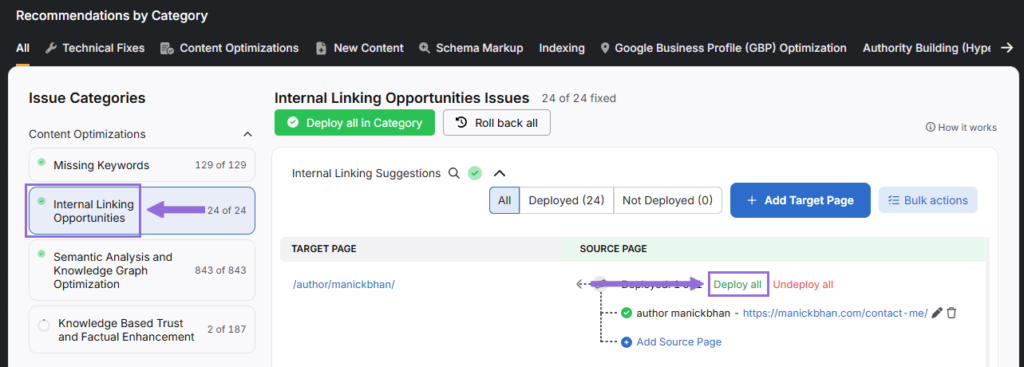
- Schema Markup. Search Atlas OTTO SEO implements the recommended schema markup for the page according to the website’s industry and Knowledge Graph. The structured data implementation enables rich results and improves search engine understanding of content.
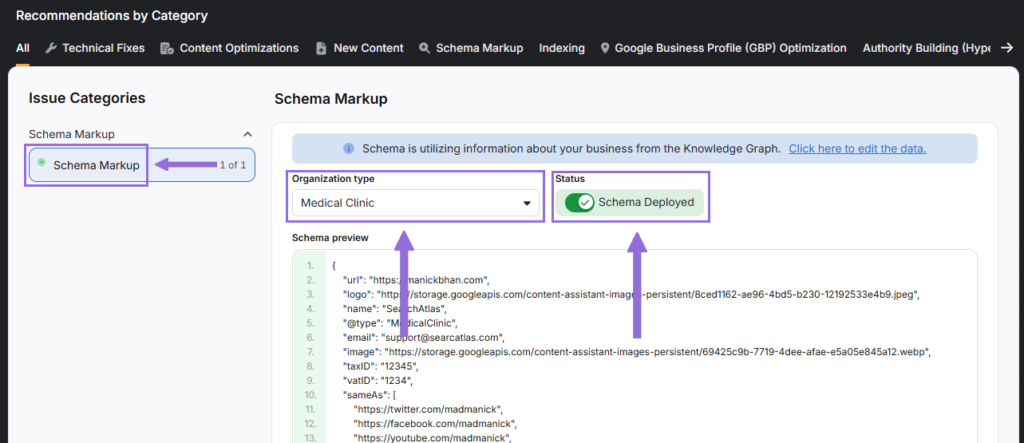
How to Do an On-Page SEO Audit?

The 4 essential steps to conduct an on-page SEO audit are listed below.
- Run a complete site crawl. Perform a full crawl using the Search Atlas On-Page SEO Audit Tool to detect issues such as missing metadata, duplicate content, and thin pages. The site crawl analysis provides a baseline understanding of the current optimization status across the entire website.
- Analyze on-page elements. Review key SEO factors like keyword placement, title tags, meta descriptions, header structure, image optimization, and internal linking to identify areas for improvement. The detailed evaluation pinpoints specific elements that require optimization to enhance search performance.
- Identify user experience issues. Examine factors affecting user experience, like intrusive interstitials or pop-ups. Evaluate content accessibility (font size, contrast, etc.), review mobile usability issues, and assess navigation clarity and breadcrumb implementation. User experience factors directly impact engagement metrics, which influence rankings.
- Track and report results. Use tools like Search Atlas and Google Search Console to monitor keyword rankings, traffic trends, and performance metrics, generating an on-page SEO report to guide ongoing optimization efforts. The continuous measurement ensures optimization efforts produce tangible improvements in search visibility and user engagement.
After concluding the on-page SEO audit, develop a structured implementation plan. You should categorize issues by impact level (high, medium, low) and prioritize fixes based on the effort required and potential benefit. Create a timeline for implementation, assign responsibilities for specific tasks, and establish a follow-up audit schedule. The output should be a guide for the on-page SEO process and improvements.
What Are the Best On-Page SEO Tools?
The best on-page SEO tools analyze, optimize, and improve on-page elements to ensure webpages are fully optimized for search engines and user experience. The best on-page SEO tools identify optimization opportunities, implement improvements, and track performance to enhance rankings and engagement. The selection of appropriate tools significantly impacts the effectiveness and efficiency of on-page optimization efforts.
The best on-page SEO tools include official Google tools, such as Google Search Console, Google PageSpeed Insights (PSI), and Google Analytics 4 (GA4), alongside AI-powered solutions like the Search Atlas SEO software platform. These tools provide essential data and automation for optimizing on-page SEO elements. The combined use of multiple specialized tools creates a comprehensive optimization approach.
Google Search Console (GSC) monitors on-page SEO performance by providing insights into keyword performance, impressions, click-through rates, and search visibility. GSC allows you to analyze specific pages with the URL inspection tool, identifying potential indexing issues and offering actionable insights for optimization. The detailed performance data helps prioritize optimization efforts based on actual search behavior.
Google Analytics 4 (GA4) tracks user behavior on individual pages, providing detailed metrics on user engagement, conversion funnels, and session behavior across pages. With enhanced measurement features, GA4 tracks scroll depth, outbound clicks, and site searches, offering a comprehensive understanding of user activity and content performance. The behavioral insights help identify content gaps and engagement opportunities.
Google PageSpeed Insights (PSI) measures webpage loading speed and Core Web Vitals, identifying areas for improvement, such as image optimization, JavaScript performance, and server response times. A fast, user-friendly page enhances SEO rankings and engagement. The detailed recommendations provide specific technical improvements to enhance page performance across mobile and desktop devices.
Search Atlas SEO Software Platform is an all-in-one advanced on-page SEO tool that leverages AI to perform keyword research and integration, audit and improve content quality, optimize metadata, enhance URLs, create and implement schema markup, enhance headings, provide question format headings, add and improve internal links, optimize anchor text, and enhance page speed.
Combining Google’s tools with Search Atlas’s on-page SEO tools creates a powerful system for optimizing on-page SEO.
What is the Difference Between On-Page SEO and Technical SEO?
While on-page SEO and technical SEO are closely related and sometimes overlap, they focus on different aspects of website optimization. On-page SEO focuses on optimizing content and visible page elements. It targets individual pages to improve relevance for specific keywords. On-page SEO is primarily concerned with what users see and experience directly, and the goals of on-page SEO include improving content quality, relevance, and user engagement.
Technical SEO focuses on website infrastructure and backend elements and targets site-wide technical aspects that affect crawling and indexing. Technical SEO is primarily concerned with how search engines access and process your site. Its goals include improving crawlability, indexability, and technical performance. Technical SEO includes optimizations like site architecture, semantic HTML tags, site security, XML sitemaps, robots.txt, meta robot tags implementation, duplicate content, pagination, internal linking, and broken links.
What is the Difference Between On-Page SEO and Off-Page SEO?
On-page SEO and off-page SEO represent two distinct but complementary approaches to improving search visibility. Each focuses on different aspects of optimization and requires different strategies and implementation methods.
On-page SEO focuses on optimizing elements within your own website and involves content and HTML source code optimization. On-page SEO is directly controlled by the website owner, and it emphasizes relevance signals to search engines. On-page SEO includes elements like keyword optimization, title tags, meta descriptions, header structure, internal linking, and content quality.
Off-page SEO focuses on external factors outside your website and involves building relationships and reputation online. Off-page SEO is partially outside the direct control of the website owner, and it emphasizes authority and trustworthiness signals. Off-page SEO relies on external factors such as link building, digital PR, social media signals, and brand authority that occur outside the website itself.


